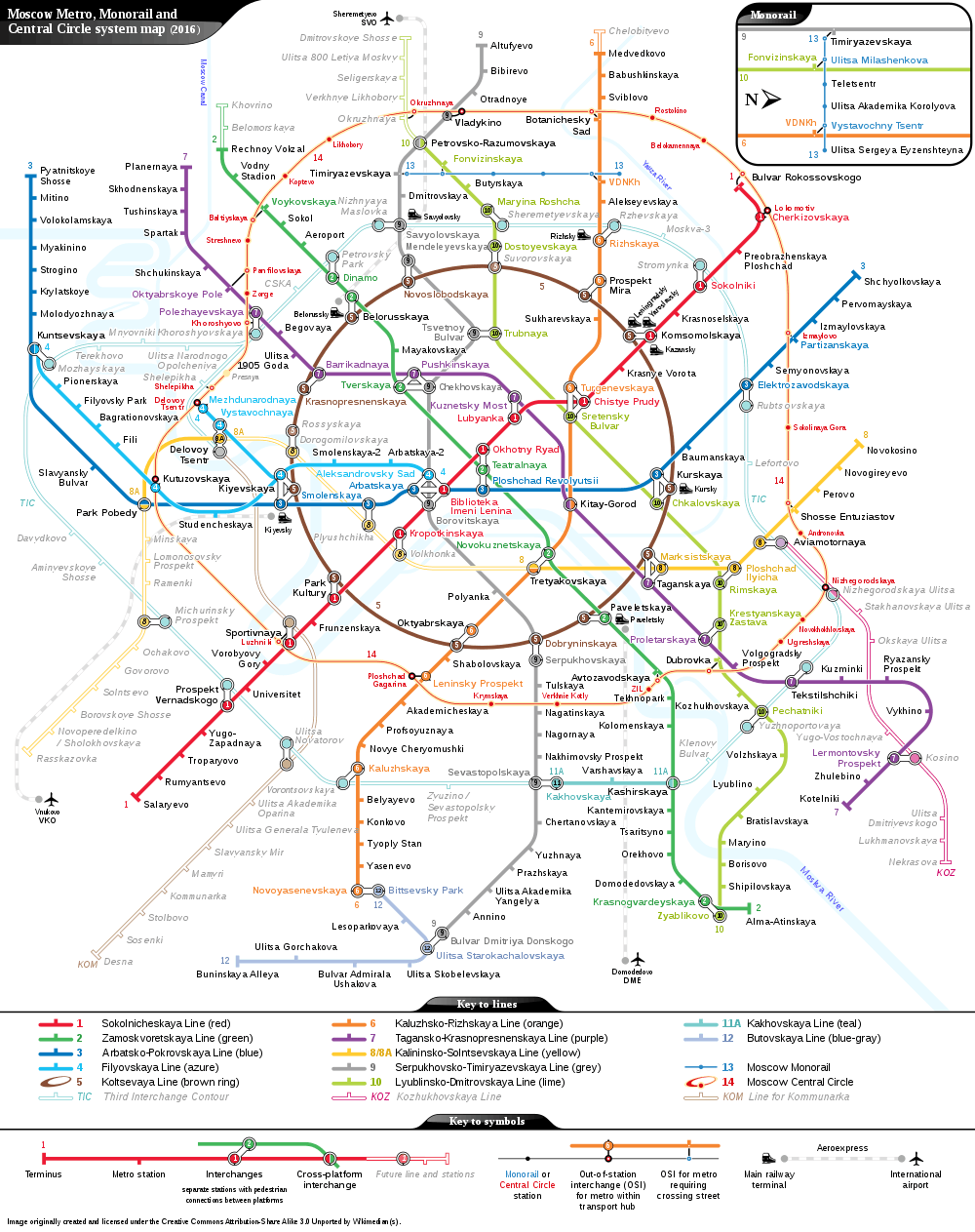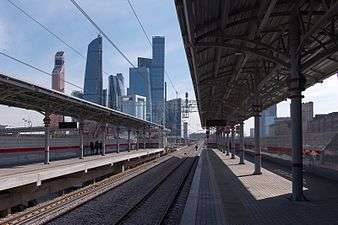Moscow Central Circle
The Moscow Central Circle or MCC (Russian: Московское центральное кольцо, МЦК),[1][2] designated Line 14 or just Encircle Line (Russian: Окружная линия) and marked in a strawberry red/white color is a 54-kilometre-long (34 mi) orbital commuter rail line that encircles historical Moscow. The line is rebuilt from the Little Ring of the Moscow Railway and opened to passengers on 10 September 2016.[3][4] and is operated by the Moscow Government owned company MKZD through the Moscow Metro, with the state-run Russian Railways selected as the operation subcontractor. The infrastructure, trackage and platforms are owned and managed by Russian Railways,[5] while most station buildings are owned by MKZD.
History
The railroad was commissioned in 1897 under the auspices of Czar Nicholas II, thus earning a "Royal Railroad" nickname.[6] The planning took five years. Thirteen design alternatives were reviewed in the process. The winning bid was for a four-track rail line, with two tracks allocated for freight, and the other two used by passenger trains. The project came with an estimated 40 million ruble price tag.
In May 1902, construction began. Following a defeat in the 1905 Russo-Japanese War, construction was scaled back. As the costs overran the estimate by a third, the number of tracks being built was reduced to two. Bridges, of which there are 35 (4 big and 31 small), were particularly costly. Their low clearance hindered electrification efforts for over a century to come.[7] The vast railroad infrastructure included housing facilities, water towers, smithies, and miscellaneous shops.[8][7] Station houses — architectural masterpieces built in the typical early-20th-century Russian industrial style[9] — had electricity.[8] Heat was provided by masonry heaters, some of which were Russian-made, and some imported from Holland. Station clocks were purchased from Swiss manufacturer Paul Buhré. Known for their accuracy, these clocks, for a while, became the city's de facto time standard. Only one such clock has survived. It is located in Presnya station supervisor's office.
The first train ran in 1907.[6] On July 19, 1908, the railroad officially opened. The opening ceremony was attended by the Czar, Royal Dynasty members, and government and city officials.
In the first few months, the railroad was used exclusively for passenger traffic. Due to a high train fare — at 3.40 rubles — ridership was virtually non-existent, and the line brought in the total of 132 rubles in revenue since the operation started. Thus, on October 10, 1908, passenger trains were discontinued in favor of freight service.
Between World War I and the October Revolution of 1917, the passenger service was restored, although freight remained the only viable revenue source. By the late 1920s, other forms of public transportation had emerged, and, in 1934, passenger service was ended, only to resume, again, 82 years later.
Development

Around 2010, many millions of people utilized the city's subway system daily. Some 35-40% used private transportation, leading to severe road congestion.[10]
Upgrade plans for the railway line were signed by Russian Railways and the Moscow Government between 2008 and 2011 with consent of Vladimir Putin (Prime Minister at the time). Construction work planned for 2013–2016 would convert the Little Ring line of the Moscow Railway for joint passenger and freight use but in 2012, at a meeting with new Prime Minister Dmitry Medvedev in Odintsovo, Moscow Mayor Sergey Sobyanin acknowledged that trains on the circle railway would not be fully ready until 2020.[10] The required work included:
- Electrification of the whole line with 3 kV DC overhead wires and the construction of substations
- Complete track replacement with additional third track on the northern half of the circle
- Construction of new passenger stations and rehabilitation of old yards
- Construction of Podmoskovnaya depot for EMU trains
- Construction of an additional second track and station upgrades on the northern section of the Greater Ring of the Moscow Railway (a large orbital line outside the city), for the re-routing freight traffic away from central Moscow
- Replacement for most bridges and overpasses
- New rolling stock specifically designed for urban service
- Construction of transfers with existing and under construction Moscow Metro stations
Construction commenced in 2012, and passenger services began in the third quarter of 2016.[6][11] During the reconstruction of the railway, many of the original passenger stations were re-purposed for passenger use and complemented with new stations.[12]
Opening and operation

The line opened on September 10, 2016 in the presence of President Vladimir Putin and Moscow Mayor Sergey Sobyanin.[13] The line is free to ride for the first month of operation.[14][15] By the end of 2016, the daily ridership on the Central Circle Line is expected to reach 400,000 and by 2025, the ring railway is expected to carry up to 300 million passengers annually.
The operation of the Central Circle is similar to the S-Train systems in Germany and other countries.[16] Ticketing on the Moscow Central Circle is fully integrated with the Moscow Metro; the same payment cards (such as the Troika card) can be used on both systems, and free transfers will be possible within 90 minutes since the first entry into the system, in a way similar to the transfers between the Metro proper and the Moscow Monorail.[17] The line serves the purpose of a connector between the different radial lines of outer Moscow, much as the Koltsevaya Line does in inner Moscow.[18] According to Moscow's deputy mayor, 130 trains per day will circulate around the circle line, with a frequency of 5–6 minutes during the rush hours, and 10–15 minutes at other times. The line's hours of operation will be the same as the rest of the Metro, from 06:00 until 01:00.[19]
Despite its name, the Moscow Central Circle is not circle-shaped. The line stretches 12 kilometres (7.5 mi) outward in the northwest and draws as close as 5 kilometres (3.1 mi) to the Kremlin in the south.[6] The Metro's Third Interchange Contour (an extension of Line 11/Kakhovskaya Line), which is under construction and will also be a circle line, will reach further to the south.
An estimated 1,500,000 people lived near the line in the early 21st century.[6]
Stations

The Central Circle Line has 31 opened stations. There are 5 direct transfers to other Moscow Metro lines and 9 more free transfers available within walking distance from MCC stations.
| |
| ||
| — ↑ Loop line towards Likhobory ↑ — | |||
| Okruzhnaya | |||
| Vladykino | 9 Vladykino | ||
| Botanichesky Sad | 6 Botanichesky Sad (within walking distance) | ||
| Rostokino | |||
| Belokamennaya | |||
| Bulvar Rokossovskogo | 1 Bulvar Rokossovskogo (within walking distance) | ||
| Lokomotiv | 1 Cherkizovskaya | ||
| Izmaylovo | 3 Partizanskaya (within walking distance) | ||
| Sokolinaya Gora | |||
| Shosse Entuziastov | 8 Shosse Entuziastov (within walking distance) | ||
| Andronovka | |||
| Nizhegorodskaya | |||
| Novokhokhlovskaya | |||
| Ugreshskaya | |||
| Dubrovka | 10 Dubrovka (within walking distance) | ||
| Avtozavodskaya | 2 Avtozavodskaya (within walking distance) | ||
| ZIL | |||
| Verkhnie Kotly | |||
| Krymskaya | |||
| Ploshchad Gagarina | 6 Leninsky Prospekt | ||
| Luzhniki | 1 Sportivnaya (within walking distance) | ||
| Kutuzovskaya | 4 Kutuzovskaya | ||
| Delovoy Tsentr | 4 Mezhdunarodnaya | ||
| Shelepikha | |||
| Khoroshyovo | 7 Polezhayevskaya (within walking distance) | ||
| Zorge | |||
| Panfilovskaya | 7 Oktyabrskoye Pole (within walking distance) | ||
| Streshnevo | |||
| Baltiyskaya | 2 Voykovskaya (within walking distance) | ||
| Koptevo | |||
| Likhobory | |||
| — ↓ Loop line towards Okruzhnaya ↓ — | |||

 Delovoy Tsentr Station, adjacent to International Business Center
Delovoy Tsentr Station, adjacent to International Business Center.jpg)

Rolling stock
The line is operated by 33 Siemens ES2G Lastochka trains and Podmoskovnaya depot. Andronovka, Lihobory and Presnya MK MZD yards also serves as depots.
 Electric multiple-unit ES2G-032 "Lastochka" leaves Luzhniki Station
Electric multiple-unit ES2G-032 "Lastochka" leaves Luzhniki Station ES2G trains in depot
ES2G trains in depot
References
- ↑ "МКЖД официально переименовали в Московское центральное кольцо". ria.ru. Rossiya Segodnya.
- ↑ "МКЖД получила название Московское центральное кольцо".
- ↑ Rupasova, Anastasia (2016-09-09). "How Moscow's new light rail system will make life easier for passengers". (The author incorrectly refers to the system as "light rail", even as she correctly identifies the rolling stock as Lastochka, which is a standard railway trainset)
- ↑ "Власти Москвы запустят МЦК для пассажиров 10 сентября (Moscow's authorities will start operating passenger service on Moscow Central Ring on September 10)".
- ↑ "Стартовал второй этап тестовой обкатки «Московской кругосветки»". www.gudok.ru. Retrieved 2016-12-04.
- 1 2 3 4 5 "Московская кругосветка № 23 (54)" (PDF) (in Russian). Большая Москва. 2015-06-24. Retrieved 2016-03-18.
- 1 2 "История МЦК". Единый Транспортный Портал. Retrieved 16 September 2016.
- 1 2 Кочкурова, Анна. "Альбом сооружений Московской окружной железной дороги 1903-1908 гг.". История России до 1917 года. Retrieved 15 September 2016.
- ↑ Агеева Р.А. и др, Р.А. и др (2007). Имена московских улиц. Топонимический словарь. Moscow: ОГИ. Retrieved 28 December 2011.
- 1 2 "Премьер Дмитрий Медведев провел совещание по развитию московского транспортного узла до 2020 года (Prime Minister Medvedev chaired a meeting on the development of Moscow transportation hub thru 2020". rbc.ru. Archived from the original on December 8, 2015. Retrieved 2015-09-13.
- ↑ И. Ленский (2015-06-27). "Здравствуй, городская электричка! Интервью гендиректора ОАО "МКЖД" А. В. Зотова" (in Russian). Без штампов. Retrieved 2016-03-18.
- ↑ "Moscow City Transport (Mosgortrans)".
- ↑ "Вечерняя Москва - Владимир Путин и Сергей Собянин открыли движение на Московском центральном кольце" (in Russian). Вечерняя Москва. 2016-09-10. Retrieved 2016-09-10.
- ↑ "МКЖД получила название "Вторая кольцевая линия" на схеме метро Москвы" (in Russian). ТАСС. 2016-06-07. Retrieved 2016-06-12.
- ↑ "Сергей Собянин: Первый месяц МЦК будет работать бесплатно" (in Russian). Официальный сайт мэра Москвы. 2016-08-31.
- ↑ "mkmzd.ru - неофициальный сайт о Малом кольце МЖД" (in Russian).
В 2016 году запланировано открытие регулярного пассажирского движения электропоездов (городская электричка) по Малому кольцу МЖД.
- ↑ Moscow Central Ring riders will be able to use standard multi-fare passes, 90 minute tickets and Troika cards, Official site of Moscow City Government
- ↑ "МЦК: До начала регулярного движения осталось меньше месяца" (in Russian). Большая Москва. 2016-08-16. Retrieved 2016-09-01.
- ↑ Как выглядит МЦК накануне открытия — The Village (Russian)
External links
| Wikimedia Commons has media related to Moscow Little Ring Railway. |
- Moscow Metro MCC page (Russian)
- Official company website (Russian)
